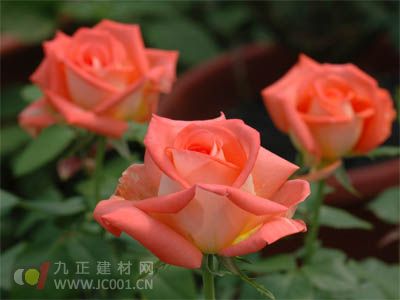Cultivation Management:
When selecting land for rose cultivation, it's important to choose deep, loose, and well-drained soil. The planting area should be prepared with pits that are 50 cm deep, spaced 50 cm apart in rows, and 150-200 cm between rows. Each pit should be enriched with 10 kg of farmyard manure or bio-organic fertilizer to ensure nutrient-rich conditions for the seedlings.
Choosing high-quality seedlings is crucial. Ideal seedlings should have 2-3 healthy branches if they're sprouting, while grafted varieties should have well-developed roots, stems about 3-4 mm thick, and a height of around 30 cm. These seedlings should be carefully packed with pulp to protect them during transport.
Proper planting density is also essential. For optimal growth, about 700 roses per acre are recommended. However, in the first year, you can densely plant up to 1,500-2,000 plants per acre to save space. In the second year, surplus seedlings can be transplanted or sold. Planting is best done in early spring before the buds appear, or during October to December in autumn. Summer planting should occur during rainy periods to reduce stress on the plants.

Effective field management includes regular weeding to prevent competition from weeds, which can harm young plants. Soil should be kept loose and well-aerated. Fertilization is primarily organic, with four key applications throughout the year: an early spring application before and after Qingming Festival to stimulate growth, a second dose in late April to support bud development, a bio-organic fertilizer application in May, and a winter fertilizer in late autumn to help the plants survive the cold. Pruning is also necessary after flowering and during dormancy to remove dead or weak branches and encourage new growth. Throughout all stages, pest and disease control must be prioritized.
Pest Control
(1) Aphids and Noctuidae: These pests damage tender shoots and leaves. A solution of 40% omethoate diluted to 2000 times or methamidophos can be sprayed to control them.
(2) Scarabs and small tigers: These insects attack the roots. Poison baits can be used to trap and eliminate them.
(3) Rust: This fungal disease affects the back of leaves and stems. Early detection and treatment are essential to prevent spread.
Cultivation Tips
Planting
Roses are typically planted directly in the ground, though some are grown in pots. They thrive in areas south of the Yellow River, where winters are mild. In colder northern regions, potted plants should be moved indoors or buried in trenches for winter protection. Planting should take place after the leaves fall in autumn or before new growth begins in spring. Choose a sunny, elevated location with good drainage. Plant at a depth of 15 cm. For pot planting, mix humus soil, garden soil, and river sand with decomposed manure or cake fertilizer to create a nutrient-rich medium. After planting, water thoroughly and keep the seedlings in the shade for a few days before gradually exposing them to sunlight.
Light and Temperature
Roses require plenty of sunlight for healthy growth. Whether planted in the ground or in pots, they should receive at least 4 hours of direct sunlight daily. Avoid placing them in dimly lit rooms for extended periods. During winter, bring potted plants indoors and place them in a sunny spot. The ideal temperature range is 12–28°C, and they can tolerate temperatures as low as -20°C. In the Zhengzhou region, roses can safely overwinter outdoors.
Watering and Fertilizing
Before planting, apply organic fertilizer to the planting hole and water after planting. Ground-planted roses don't require strict watering schedules, but three main fertilizations are recommended. First, apply decomposed manure and leaf mold before spring buds emerge. Second, use cooked cake slag after flowering to replenish nutrients. Third, apply manure after the leaves fall to prepare for winter. Potted roses benefit from regular feeding—once every 10–15 days. While roses are drought-tolerant, they should be watered once every 20–30 days during dry seasons. In summer or spring droughts, potted plants may need daily watering for two days. Applying a high-fat film spray can help retain moisture and protect the plants.
Pruning
Minimal pruning is usually needed, but old, dense, or diseased branches should be removed to promote healthy growth. When picking flowers, do so by cutting just below the bloom to encourage more flowers to open. If left unpruned, a single flower may only bloom once.
Flowering Control
Natural flowering is often the best approach. During the bud stage, the flowers develop into beautiful blooms and remain vibrant for an extended period.
Five Methods of Rose Propagation: 1. Seed propagation, 2. Vegetative propagation, 3. Cuttings, 4. Layering, and 5. Grafting.
Small Round Roses (actually miniature roses)
These compact varieties have small flowers, measuring about 1.5 to 2.5 cm in diameter. They form tulip-like inflorescences and are perfect for small pots or flower beds, adding a charming touch to any garden. They symbolize the beauty of a small sunset.
Vine Species (actually climbing roses)
Climbing roses are not only ornamental but also have medicinal uses. Their petals are dried and used for their fragrance, blood circulation, and astringent properties. Rose buds can be distilled to extract rose oil. The fruit is rich in vitamin C and is used as a natural source for beverages and food products.
Brick And Stone Series Pattern Roller
Brick And Stone Series Pattern Roller,3D Brick Pattern Paint Roller,Art Design Brick Paint Roller,Rick Embossing Roller With Rubber Handle
Jiangmen Nichiyo Decorative Material Co.,Ltd. , https://www.nichiyopt.com